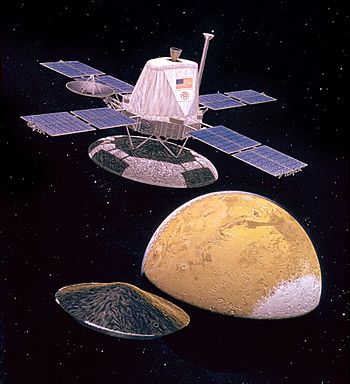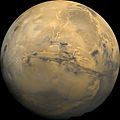Viking program facts for kids

Artist impression of a Viking orbiter releasing a lander descent capsule
|
|
| Manufacturer | Jet Propulsion Laboratory / Martin Marietta |
|---|---|
| Country of origin | United States |
| Operator | NASA / JPL |
| Applications | Mars orbiter/lander |
| Specifications | |
| Design life | Orbiters: 4 years at Mars Landers: 4–6 years at Mars |
| Launch mass | 3,527 kilograms (7,776 lb) |
| Power | Orbiters: 620 watts (solar array) Lander: 70 watts (two RTG units) |
| Regime | Areocentric |
| Dimensions | |
| Production | |
| Status | Retired |
| Built | 2 |
| Launched | 2 |
| Retired | Viking 1 orbiter August 17, 1980 Viking 1 lander July 20, 1976 (landing) to November 13, 1982 Viking 2 orbiter July 25, 1978 Viking 2 lander September 3, 1976 (landing) to April 11, 1980 |
| Maiden launch | Viking 1 August 20, 1975 |
| Last launch | Viking 2 September 9, 1975 |
The Viking program was a big NASA mission. It sent two spacecraft to the planet Mars. These spacecraft were named Viking 1 and Viking 2. Each one had two main parts. One part was an orbiter. The other part was a lander.
The orbiters flew around Mars. They took many pictures of the planet. They also sent important information back to Earth. The landers went down to the surface of Mars. There, they collected scientific data. They studied the planet's ground and air.
Mission Timeline
Both Viking spacecraft launched in 1975. They both arrived at Mars in 1976. Scientists used pictures from the orbiters. These pictures helped them choose safe landing spots. After that, the landers separated from the orbiters. They carefully landed on Mars.
The orbiters kept taking pictures. Meanwhile, the landers explored the surface. All four parts of the mission worked longer than planned. Eventually, they stopped working. The Viking 2 Orbiter stopped in 1978. The Viking 1 Orbiter and Viking 2 Lander stopped in 1980. The Viking 1 Lander worked the longest, until 1982.
Why Viking Was Important
The Viking program was a very expensive mission. It cost about US$1 billion. It was also one of the most difficult missions to Mars. But it was very successful.
Most of what we knew about Mars came from Viking. This was true until the late 1990s. The mission taught us a lot about the Red Planet. It helped future missions to Mars.
Images for kids
-
Carl Sagan with a model of a Viking lander.
See also
 In Spanish: Programa Viking para niños
In Spanish: Programa Viking para niños




